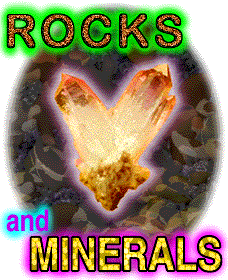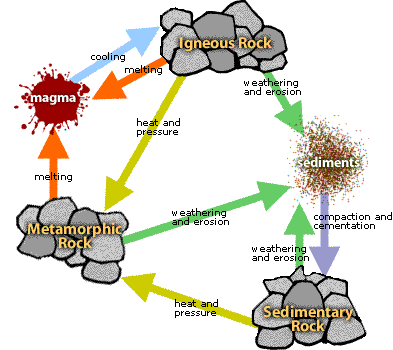|
LESSON 2- HOW ARE
ROCKS FORMED?
AIMS:
1. What are sedimentary rocks?
2. What are igneous rocks?
3. What are metamorphic rocks?
MOTIVATION: Now
that we know what rocks are and how to identify some of their properties,
who can tell us how they think the rocks formed? Have students log
on to
http://fi.edu/tfi/units/rocks/rocks.html to find out what forms
rocks. (Pressure, temperature, erosion and friction). Show students
pictures of each type of rock and ask them to identify their properties.
The sedimentary rock is sandstone from Utah. It was taken from
http://rocksforkids.com/howrocks.html#Sedimentary. The
igneous rock is granite. The picture is from
http://ivyhall.district96.k12.il.us/4th/kkhp/RocksandMinerals/granite.html.
The metamorphic rock is quartz. The picture is from
http://ivyhall.district96.k12.il.us/4th/kkhp/RocksandMinerals/metamorphic.html.
For a student database,
click here.
|
Type of Rock |
Description of Properties |
Sedimentary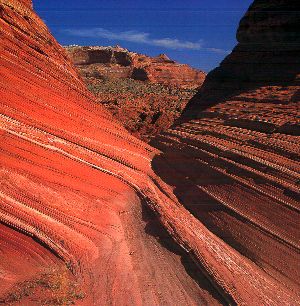 |
You can see many layers.
There are many colors. You can tell they were made over a long
period of time. |
Igneous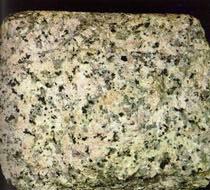 |
You can see many different
colored large crystals in this rock. You can tell it cooled
slowly so the crystals could grow. |
Metamorphic |
The rock is very shiny
or glassy. You can tell it was made under great pressure and
heat. |
Procedure:
1. Children are
to log on to
http://ivyhall.district96.k12.il.us/4th/kkhp/RocksandMinerals/granite.html
and complete the following database to find out how each type of rock is
formed. For a blank student database,
click here.
|
NAME |
CAUSE |
LOCATION |
CHARACTERISTICS |
Sedimentary
limestone;
sandstone; chalk; coal; rock salt; shale; dolomite; conglomerate
|
created
when layers of sediment (mud, sand, gravel and minerals) settle to
the bottom of the ocean and then compacted (pressed together) over
thousands of years
|
where
oceans or bodies of water once existed or still exist
|
soft,
layered, may contain fossils
|
Igneous
quartz;
pumice; granite; basalt; obsidian
|
created
when molten rock (lava) inside the Earth pushes through the crust
(like in a volcanic eruption) and then cools
|
where
volcanoes have or do exist
|
crystalline, glossy, coarse-grained
|
Metamorphic
marble;
slate; gneiss; schist; quartzite; eclogite
|
created
when sedimentary or igneous rocks undergo metamorphosis (change)
caused by pressure, heat, and water acting on the rocks
|
deep within the
earth (where pressure and heat have a very large affect) |
hard, may
contain bands or layers, may contain crystals
|
2. Children can access the
following animated graphics to show how sedimentary, igneous, and
metamorphic rocks are formed. This information is from the
Rock Hound at
http://fi.edu/fellows/payton/rocks/create/sediment.htm
|
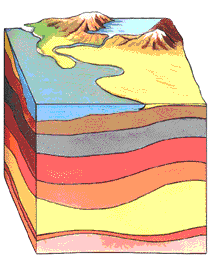
SEDIMENTARY
|
|
IGNEOUS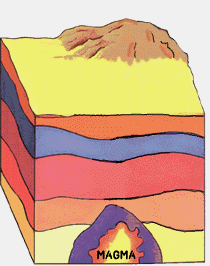
|
|
METAMORPHIC
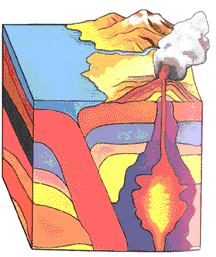
|
3. Divide the class into two
groups. Have each group choose one of the following laboratory
activities taken from Earth Science for Every Kid, by Janice
VanCleave.
LAB ACTIVITIES:
|
Problem: How can we demonstrate the formation of
metamorphic rocks? Hypothesis:
We think if we use a book to create pressure on some objects, then
we can simulate the creation of metamorphic rocks.
Materials: 20 flat
toothpicks, heavy book
Procedure: 1. Snap the
toothpicks in half, but leave them connected. 2. Pile
the toothpicks on a table. 3. Place the book on top of
the toothpick pile and press down. 4. Remove the book.
Observations: The
students observe that the toothpicks are pressed into flat layers.
Conclusion: The
toothpicks flatten into layers under the pressure of the book.
in nature, the weight of rocks at the surface pushes down on rock
and dirt beneath, forcing them to flatten into layers. Rocks
formed by great pressure are called metamorphic rocks. |
|
Problem: How can we demonstrate a sedimentary rock
formation? Hypothesis:
We think if we can layer various substances then we can show the
formation of sedimentary rocks.
Materials: 2 slices of
bread, crunchy peanut butter, jelly, knife, (for spreading), and
plate
Procedure: 1.
Lay one slice of bread on a plate. 2. Use the knife to
spread a layer of peanut butter on the slice of bread. 3.
Add a layer of jelly on top of the peanut butter layer.
4.Place the second slice of bread on top of the jelly layer.
5. Eat the sandwich!
Observations: The
students observe a series of layers that can be differentiated by
color and texture.
Conclusion:
Sedimentary rocks are formed from loose particles that have been
carried from one place to another and redeposited. These rocks
are usually deposited in a series of layers similar to the layers in
the sandwich. Each layer can be distinguished by differences
in color, texture, and composition. The oldest layer and
lowest bed is deposited first and the youngest layer is at the top.
The layers over a period of time become compacted and cemented
together to form solid rock. |
INTERNET ACTIVITIES:
Become a rock expert! Take
the rock quiz on how different rocks are formed. Log on to the
Rock Hound here:
http://fi.edu/fellows/payton/rocks/quiz/index.html
FOLLOW-UP:
This lesson will lead to Lesson 3- "What
is the Rock Cycle?"
|


